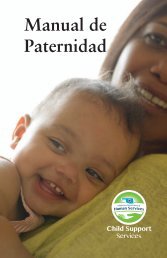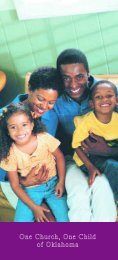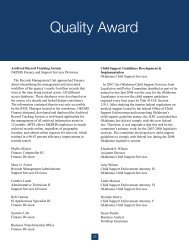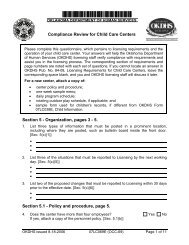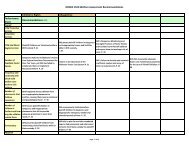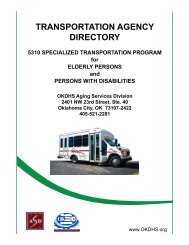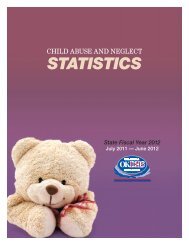The Oklahoma Pinnacle Plan - Oklahoma Department of Human ...
The Oklahoma Pinnacle Plan - Oklahoma Department of Human ...
The Oklahoma Pinnacle Plan - Oklahoma Department of Human ...
You also want an ePaper? Increase the reach of your titles
YUMPU automatically turns print PDFs into web optimized ePapers that Google loves.
<strong>The</strong> <strong>Oklahoma</strong> <strong>Pinnacle</strong> <strong>Plan</strong>: March 2012<br />
An Improvement <strong>Plan</strong> for Child Welfare Services<br />
<strong>Pinnacle</strong> Point 1<br />
We must expand quality placement options and supports to ensure<br />
safety <strong>of</strong> children in out-<strong>of</strong>-home care, reduce utilization <strong>of</strong> shelter<br />
care, and improve placement stability.<br />
WHY FOCUS ON MORE PLACEMENT OPTIONS?<br />
One <strong>of</strong> the most critical areas for improvement in the child welfare program is having an<br />
adequate number <strong>of</strong> foster parents (resource parents) for <strong>Oklahoma</strong>’s abused and neglected<br />
children. A wealth <strong>of</strong> experience and research shows that children are safer in family settings<br />
than in congregate care. Stable families provide children with life experiences they need for<br />
healthy physical, emotional, and social development. OKDHS has not been able to meet this<br />
need in the past, but that is going to change. Children, especially young children, will not be<br />
in shelters. Every child deserves to be with a family that meets his/her safety, permanency<br />
and well-being needs. Each child should be matched with a family that keeps him/her with<br />
siblings and close to school and community. Each child deserves a family that understands the<br />
impact <strong>of</strong> the trauma experienced by most children entering out-<strong>of</strong>-home care, helps the child<br />
heal from this trauma, and keeps the child even in tough times so the child doesn’t have to<br />
change placements.<br />
OKDHS shall place children according to the following standards and shall be consistent with<br />
placement preferences outlined in Section 1-4-204 <strong>of</strong> the <strong>Oklahoma</strong> Statutes and the federal<br />
Indian Child Welfare Act (ICWA). All children shall be placed in accordance with their individual<br />
needs, taking into account a child’s need to be placed as close to home and community as<br />
possible, the need to place siblings together, and the need to place children in the least<br />
restrictive, most home-like setting. Children for whom the permanency goal is adoption<br />
should, whenever possible, be placed with a family in which adoption is a possibility.<br />
Improvement in this area is critical and cuts across each <strong>of</strong> the 15 performance areas almost<br />
without exception. If each and every child has the right family, a reduction in abuse and<br />
neglect in care, placement instability, shelter care utilization, failed adoptions, and older youth<br />
aging out <strong>of</strong> the system without a permanent family should be achieved. By the end <strong>of</strong> Year<br />
One, <strong>Oklahoma</strong> needs 500 additional non-relative foster homes to help improve all <strong>of</strong><br />
these areas and to focus efforts on getting young children out <strong>of</strong> shelters. <strong>Oklahoma</strong> also<br />
needs an increase in <strong>The</strong>rapeutic Foster Care (TFC) homes to keep youth closer to their<br />
families and out <strong>of</strong> congregate care.<br />
5




